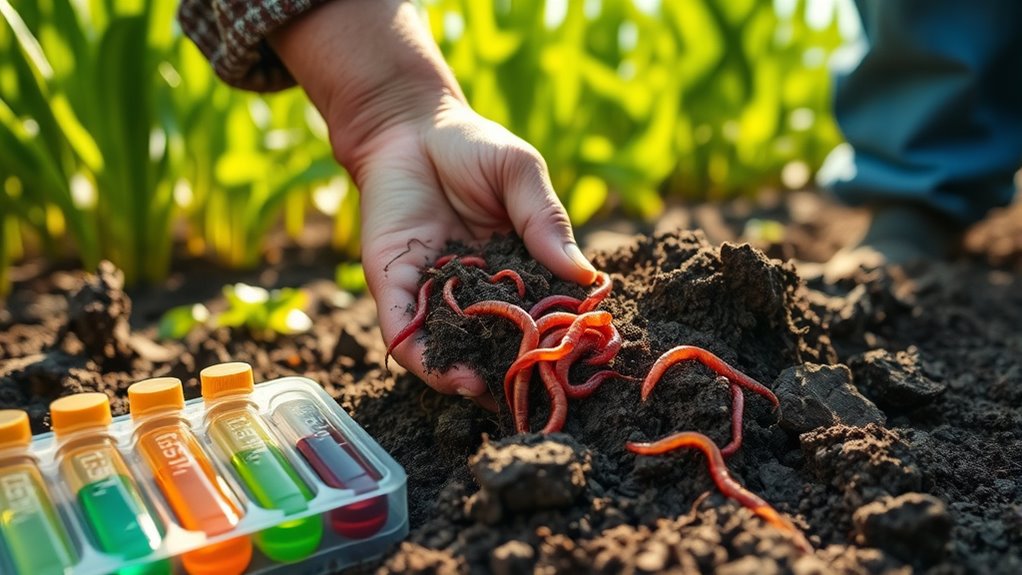To test and improve your farm's soil health, start by evaluating chemical, physical, and biological indicators. Conduct visual evaluations, count earthworms, and perform lab tests to analyze nutrient levels. Use methods like the Teabag Index to monitor microbial activity. Implement strategies such as cover cropping, reduced tillage, and crop rotations to enhance soil health. Regular testing every 1-2 years guarantees you stay on track. There's more you can explore to optimize your soil management practices.
Key Takeaways
- Conduct soil tests every 1-2 years to assess nutrient levels, pH, and microbial activity for informed management decisions.
- Use the Teabag Index to monitor microbial activity by measuring the decay rate of buried teabags over time.
- Implement cover cropping to enhance organic matter, improve soil structure, and promote nutrient cycling.
- Practice reduced tillage to maintain soil aggregates, prevent compaction, and support soil health.
- Rotate crops, incorporating legumes to naturally fix nitrogen and improve water retention and overall soil fertility.
Importance of Soil Health

Soil health is fundamental for your garden's success and the broader ecosystem. Healthy soil sustains both plant and animal life, directly influencing crop productivity and the entire food web.
By monitoring soil health, you can guarantee effective nutrient cycling and improve soil fertility, which are essential for thriving plants. Utilizing soil testing methods helps you assess organic matter content, carbon to nitrogen ratios, and fungi to bacteria ratios, all important indicators of soil vitality.
Implementing practices to improve soil health, like cover cropping and reduced tillage, enhances water regulation and stability for root growth. These practices not only boost immediate productivity but also contribute to long-term agricultural sustainability and resource conservation, assuring a healthy ecosystem for the future.
Soil Health Indicators Overview
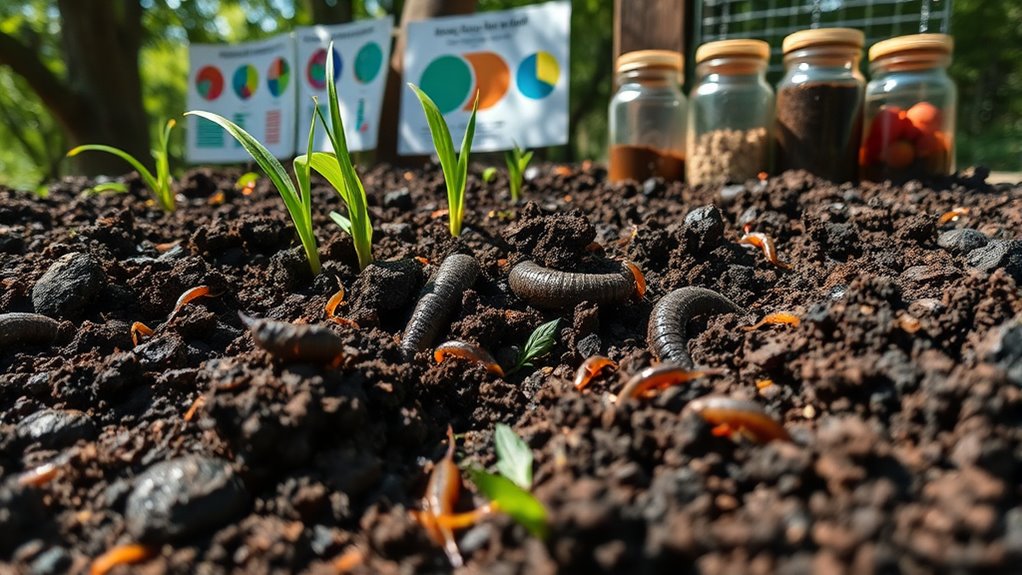
Understanding soil health indicators is essential for maintaining vibrant and productive soil.
You'll need to assess chemical, physical, and biological factors to get a complete picture of soil vitality.
Chemical Indicators Assessment
When evaluating soil health, chemical indicators play an essential role in determining the fertility and productivity of your land.
Soil test results offer valuable insights into soil pH, which ideally should fall between 6.0 and 7.5 for optimal nutrient availability. Regular soil testing can help you identify macronutrient deficiencies—like nitrogen, phosphorus, and potassium—that hinder crop growth.
Additionally, monitoring micronutrients such as zinc and boron is vital, as imbalances can impact plant performance. Salinity testing is also important; high dissolved salt levels can restrict nutrient uptake and water absorption.
Physical and Biological Factors
Evaluating soil health extends beyond just chemical indicators; physical and biological factors are also vital to the overall fertility and function of your land.
Soil structure and aggregate stability directly influence water holding capacity and nutrient availability, essential for ideal plant growth. You should monitor soil compaction, as it can restrict root penetration and hinder microbial activity, ultimately affecting crop productivity.
High organic matter content enhances soil biology, supporting diverse microorganisms that contribute to nutrient cycling.
Regularly reviewing these indicators not only informs your management practices but also promotes sustainable farming techniques, ensuring your soil remains healthy and productive for years to come.
Prioritize these physical and biological factors to improve your farm's overall soil health.
Visual Assessments of Soil Structure
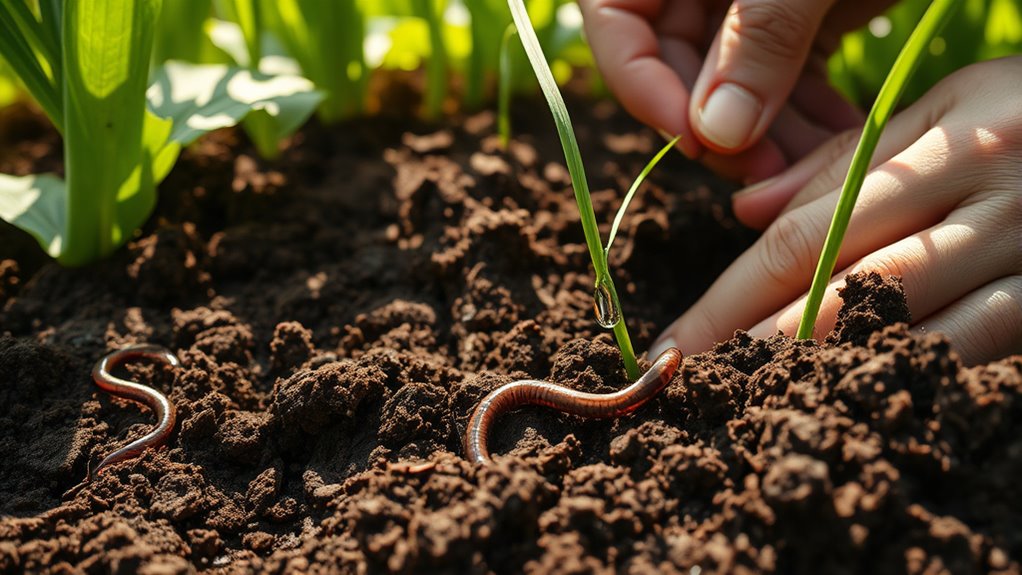
When you evaluate soil structure visually, you'll notice key characteristics like appearance, aggregate size, and color.
These elements can reveal a lot about your soil's health and its ability to support crops.
Soil Appearance Evaluation
To assess soil health effectively, you can start with a visual evaluation of soil structure, which reveals essential indicators of its condition.
Pay attention to soil appearance; darker soils often indicate higher organic matter content, enhancing soil health and nutrient availability.
During your visual assessment, observe for signs of soil aggregates, which play a significant role in soil structure.
Look for compaction signs, like limited root penetration or pooling water, as these indicate potential issues in soil biology.
Additionally, spotting earthworms and other organisms during your inspection is a positive sign of healthy soil biology, contributing to nutrient cycling.
Aggregate Size Assessment
Evaluating aggregate size is key to understanding soil structure and health. An aggregate size assessment helps you determine the stability of soil aggregates, which affects water infiltration and root growth.
Use methods like the Drop Shatter Test to visually assess how aggregates break apart, scoring them based on size and porosity. Healthy soils show a mix of small and large aggregates, promoting better aeration and water retention.
The Visual Evaluation of Soil Structure (VESS) also provides quick insights into aggregate condition. Monitoring changes in aggregate size over time can reveal the effects of management practices, such as reduced tillage and cover cropping, ultimately enhancing your soil health.
Color and Texture Analysis
Understanding soil color and texture is essential for evaluating its health and fertility, as these factors directly influence plant growth.
Here's how you can assess these characteristics:
- Assess Soil Color: Darker soil often signals higher organic matter, which boosts nutrient retention and overall soil health.
- Examine Soil Texture: Identify the proportions of sand, silt, and clay. Sandy soils drain quickly, while clay retains moisture, impacting water retention and plant growth.
- Conduct Visual Assessments: Use methods like the Munsell soil color system and the Visual Evaluation of Soil Structure (VESS) to analyze soil structure and stability.
Earthworm Counts as Soil Indicators
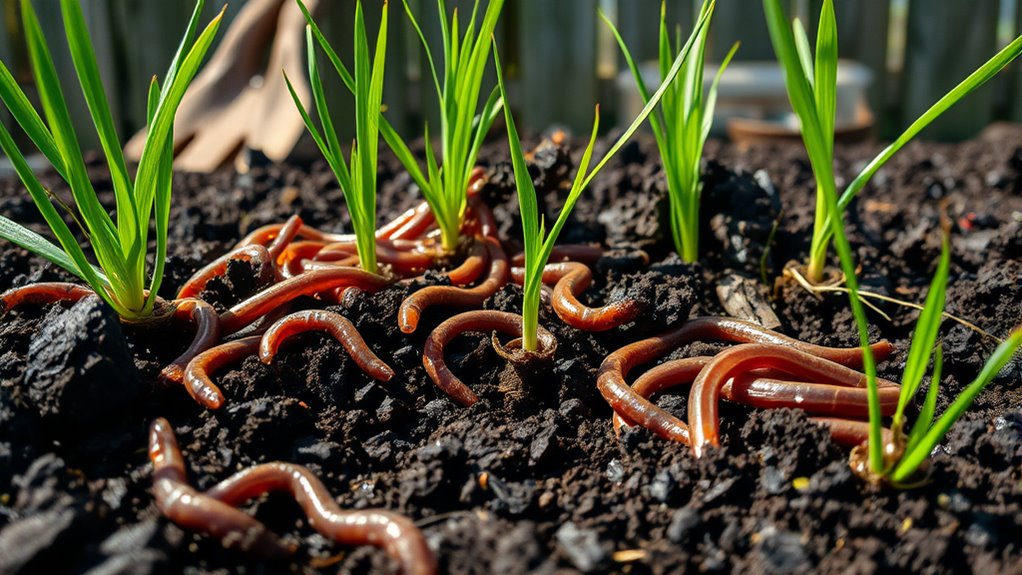
Earthworm counts are an essential measure of soil health, reflecting the overall condition of your soil ecosystem. Their presence signifies good soil structure and fertility, enhancing water infiltration and nutrient cycling.
Different earthworm species contribute uniquely; surface-dwelling types boost organic matter decomposition, while deep-burrowing types improve soil aeration.
Surface-dwelling earthworms enhance organic matter decomposition, while deep-burrowing species promote better soil aeration.
To get accurate counts, monitor these populations during spring or autumn, when earthworms are most active. A healthy soil ecosystem typically has around 10 to 20 earthworms per square foot. Lower counts could point to soil compaction or nutrient deficiencies.
Regular monitoring of earthworm populations helps you track changes in soil health, allowing you to adjust your management practices for enhanced soil health.
Lab Analysis and Soil Tests

To guarantee your soil supports healthy crops, lab analysis and soil tests are essential for uncovering significant information about its composition.
Regular testing helps you monitor nutrient levels and track changes in soil health over time. Here are three key benefits:
- Identify Nutrient Needs: Lab analysis reveals macronutrients like nitrogen, phosphorus, and potassium, guiding your fertilization strategies.
- Assess Microbial Populations: Tests like the Haney Test and PLFA Soil Test evaluate microbial biomass, helping you understand organic matter dynamics.
- Optimize Crop Rotations: By analyzing soil samples from various field locations, you can align your management practices with the nutrient profile, enhancing overall productivity.
Incorporate lab results with observational data to achieve a thorough understanding of your soil health.
Infiltration and Slake Tests
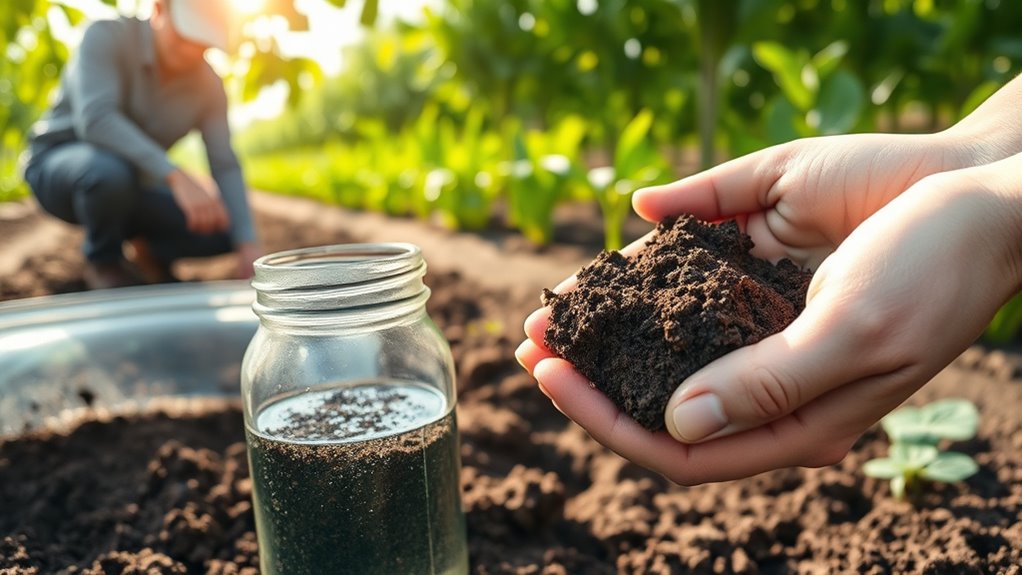
Evaluating soil health goes beyond nutrient levels; it also involves understanding how well your soil can manage water and maintain structure.
Conducting an infiltration test helps you measure the rate at which water penetrates your soil. Faster rates indicate better soil structure and less compaction, while slower rates can signal compaction issues that hinder growth.
Conducting an infiltration test reveals how efficiently water moves through your soil, indicating its structure and compaction levels.
The slake test evaluates soil structure stability by seeing how well soil aggregates hold together when exposed to water. Disintegration suggests poor structure and lower organic matter.
Both tests provide crucial insights into soil health, affecting water availability for crops and overall soil aeration. They're easy to perform with simple equipment, making them accessible tools for improving your soil management practices.
The Teabag Index for Soil Biology
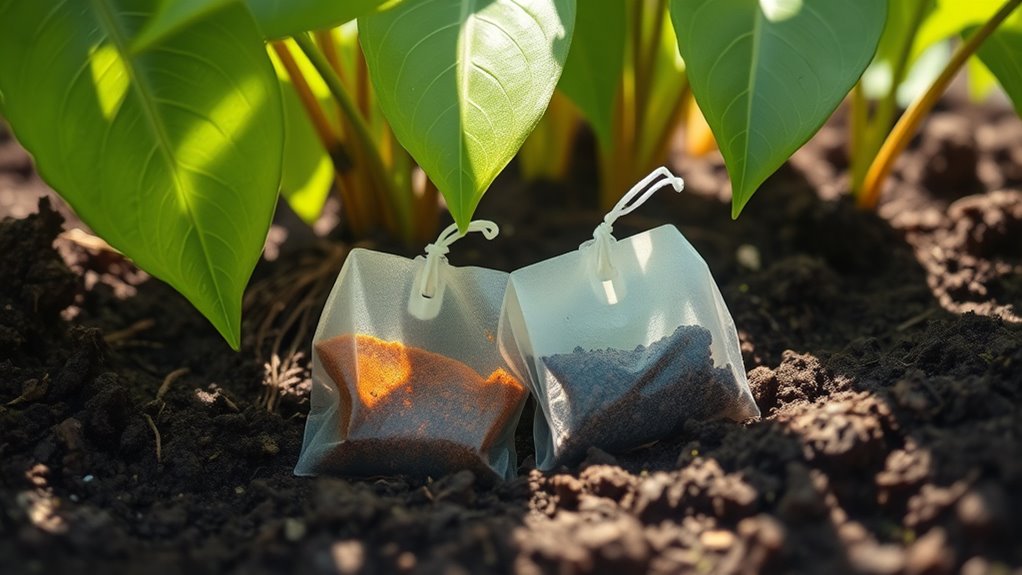
While understanding soil health often focuses on nutrients and structure, the Teabag Index offers a unique perspective by examining soil biology through the lens of microbial activity.
This method assesses the decay rate of buried teabags, providing insights into organic matter decomposition. Here's how it works:
- Burial Duration: Teabags buried for two months indicate active soil biology.
- Weight Loss Measurement: Significant weight loss after three months reflects the rate of organic matter decay.
- Cost-Effective Monitoring: This approach helps you gauge soil health and monitor changes over time.
Timing and Frequency of Soil Testing
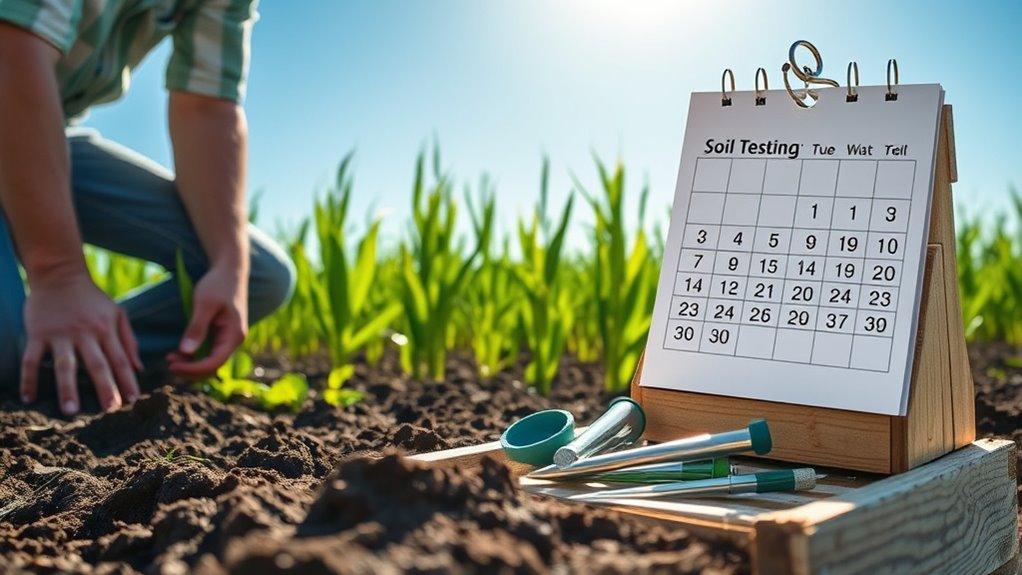
Understanding when and how often to test your soil can greatly impact your crop yields and overall soil health. Ideally, conduct soil testing in the fall to assess nutrient levels and prepare for the upcoming growing season.
For uniform areas, testing every 1-2 years is recommended, while fields with varying soil types may require more frequent testing. Regular soil sampling before planting and during the growing season helps you monitor soil nutrients and make timely adjustments to fertilization.
Consistent timing in testing enhances your ability to track changes in soil health and organic matter over time. Consulting with agriculture professionals can help you establish the best schedule for soil testing based on your crop rotation and historical practices.
Strategies for Improving Soil Health
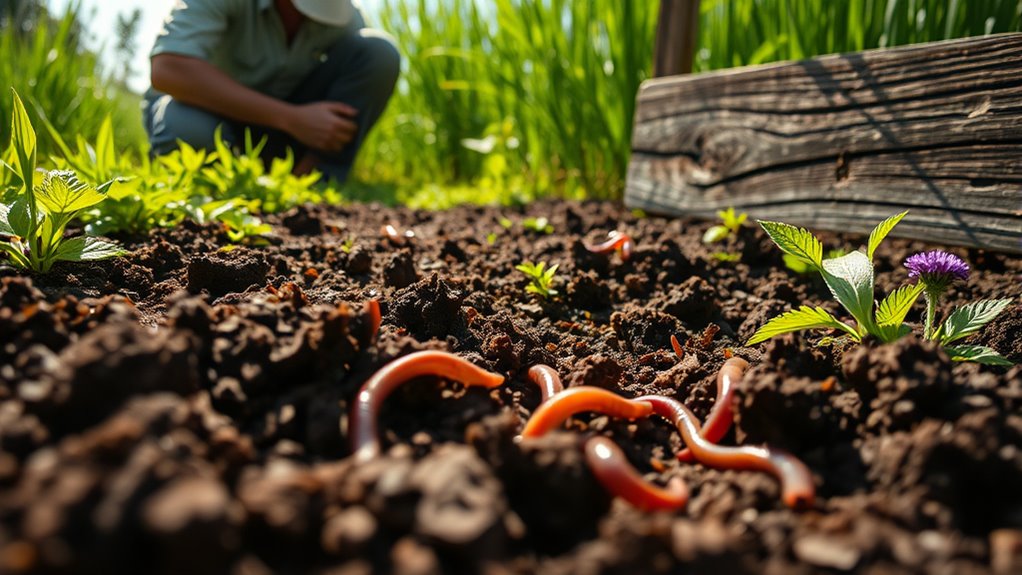
To boost your soil health effectively, consider implementing a variety of strategies that focus on enhancing its natural qualities.
Boosting soil health requires diverse strategies that enhance its natural qualities for better productivity and sustainability.
Here are three key approaches:
- Cover Crops: Planting cover crops increases organic matter, improves soil structure, and reduces erosion while enhancing nutrient cycling and water retention.
- Reduced Tillage: This practice maintains soil aggregates and prevents compaction, allowing beneficial microbial activity to thrive, which is essential for overall soil health.
- Crop Rotations: Incorporating legumes in your rotations can naturally fix nitrogen, improving nutrient availability for future crops and enhancing soil fertility over time.
Frequently Asked Questions
How Do Farmers Improve Soil Health?
You can improve soil health by incorporating cover crops to boost organic matter and encourage beneficial microbes.
Reducing tillage helps maintain soil structure and prevents compaction.
Regularly adding organic matter, like compost or manure, enriches soil biology and nutrient availability.
Crop rotation diversifies your fields, reducing pests and enhancing nutrient cycling.
Finally, using biological soil tests lets you assess microbial diversity, guiding your management practices for better soil health and productivity.
How to Test Your Soil for Farming?
Imagine your soil as a living organism, needing care and attention.
To test your soil for farming, start by collecting samples from different areas of your field. You'll want to measure key indicators like pH, nutrients, and texture.
Don't forget to conduct both chemical and physical tests for a thorough analysis. Regular monitoring of soil health indicators will help you adapt your practices, ensuring your crops thrive and your farm flourishes.
What Are the 3 Things to Improve Soil Health?
To improve soil health, start by incorporating organic matter, like compost or cover crops, which boost microbial activity and enhance soil structure.
Next, consider implementing no-till practices to minimize disturbance and preserve beneficial organisms.
Finally, diversify your crop rotations to enhance nutrient cycling and prevent pest cycles.
These three strategies will create a thriving soil ecosystem, leading to improved fertility and better crop yields.
You'll see the benefits in no time!
What Are the 5 Principles of Soil Health?
The five principles of soil health revolve around key practices you can adopt.
First, keep your soil covered with plants to prevent erosion.
Next, minimize soil disturbance by using no-till methods.
Third, implement diverse crop rotations to enhance nutrient cycling.
Fourth, manage organic matter by adding compost or manure for better water retention.
Finally, integrate livestock into your systems for natural fertilization and improved biodiversity.
These principles promote a thriving soil ecosystem.
Conclusion
In summary, taking the time to test and improve your farm's soil health is vital for thriving crops and sustainable practices. By keeping a close eye on indicators, conducting regular tests, and implementing effective strategies, you'll be well on your way to nurturing your soil. Remember, a stitch in time saves nine; addressing soil health now will pay off in the long run. So roll up your sleeves and get started on this essential journey!

